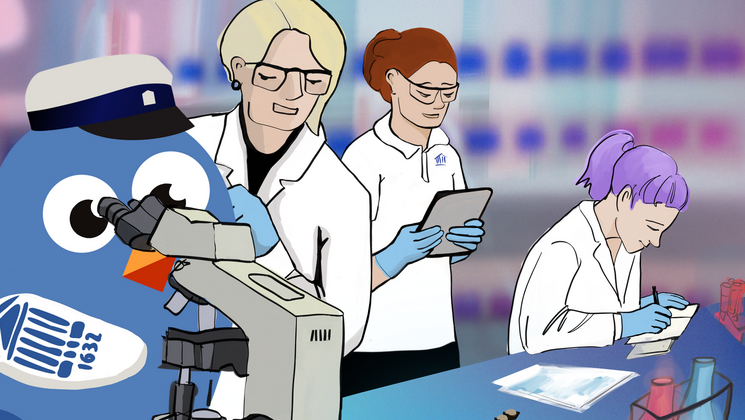University of Tartu helped to develop IT infrastructure for personalised medicine

The National Institute for Health Development has completed its forward-looking project "Implementation of Personalised Medicine in Estonia" and developed together with University of Tartu researchers the IT infrastructure for personalised medicine, enabling Estonian doctors and nurses to use genetic data for disease prevention and finding the best treatment plan for each person, says the institute's press release.
Nearly 150 experts have contributed to the R&D project "Implementation of Personalised Medicine in Estonia", which has been led by the National Institute for Health Development since 2019. The University of Tartu, the Health and Welfare Information Systems Centre (TEHIK), the Estonian Health Insurance Fund and the Ministry of Social Affairs were involved as partners. The project aimed to establish an IT infrastructure to bring new national services to personalised medicine. In addition, the service process was developed and the related information systems needed to deliver the service were upgraded.
The personalised medicine IT infrastructure is an innovative and unique solution not only in Estonia but worldwide. "Completing the infrastructure is an important step in improving the healthcare system. This will make it possible to provide patients with more accurate treatment and better prevent disease. The results of the project create the basis for future innovative services in Estonia," said Annika Veimer, Director of the National Institute for Health Development. In the project, it has been kept in mind that the services to be created should be available for all Estonian citizens and not limited to existing gene donors.
A lot of work in developing the IT infrastructure has been done by the team led by Professor Jaak Vilo at the University of Tartu Institute of Computer Science. "In the large project, we had to find a solution that suited the different parties and constraints and implement it. Software development went without major glitches and is in line with current capabilities. In addition to a solution for data management and data exchange between the different parties, we showed that it is possible to make research-based computational models work on the infrastructure while protecting genetic data against data leaks. This opens the way to a market for similar computational models and shows what needs to be done to move innovation from the research lab to practical use," said Vilo.
In addition to a solution for data management and data exchange between the different parties, we showed that it is possible to make research-based computational models work on the infrastructure while protecting genetic data against data leaks. This opens the way to a market for similar computational models and shows what needs to be done to move innovation from the research lab to practical use.
According to Professor Mait Metspalu, Director of the University of Tartu Institute of Genomics, in the case of the completed personalised medicine infrastructure, the most specific task of the biobank is to enable the secure transfer of a person's genetic data to the Genetic Data Information System (GAIS) based on the person's consent. "Among other things, it is worth mentioning that the data collected in the biobank for scientific use has undergone further quality checks and is now declared suitable for use in the medical system. This way, a gene donor does not have to go back for a blood test to receive the personalised medicine services that will be available, and, ultimately, it is cost-effective for the state. It is a pleasure to see that the long-standing vision of the biobank is gradually becoming a reality, meaning that gene data will not only benefit scientific progress but also the people themselves," Metspalu added.
...the data collected in the biobank for scientific use has undergone further quality checks and is now declared suitable for use in the medical system. This way, a gene donor does not have to go back for a blood test to receive the personalised medicine services that will be available, and, ultimately, it is cost-effective for the state. It is a pleasure to see that the long-standing vision of the biobank is gradually becoming a reality, meaning that gene data will not only benefit scientific progress but also the people themselves.
At the initiative of TEHIK, several new functions have been added to the Health Information System. One of the most important developments is linking genetic data and the computing environment to the Health Information System. This will provide the opportunity to centralise genetic data in the future, but, for the time being, the aim is to provide new personalised medicine services, such as calculating the overall risk of breast cancer. "In the provision of services based on genetic data, the security of information systems is important, as well as the management of people's consent to avoid unauthorised use of data. Data security, together with legitimate use, is certainly one of TEHIK's priorities. We have also made other important technological innovations – improved cloud architecture and implemented microservices," said Tanel Tera, Head of e-Services at TEHIK. The functions created in the project are part of a new, modern and forward-looking health information system, enabling more accurate genetic analysis and supporting health professionals in treatment planning and decision-making.
The project also included training family doctors and nurses on medical genomics and personalised medicine, with a total of 555 health professionals participating. The training courses aimed to update and harmonise health professionals' knowledge in the field of medical genomics and develop skills in genetic risk counselling.
There are still two tasks to be solved to start providing the services: the legal act, the draft of which is in the final stages of drafting in the Ministry of Social Affairs, and the certified software medical devices, the procurement of which is being handled by the Estonian Health Insurance Fund. "Once these last pieces of the puzzle have been solved, personalised medicine services will be ready to be offered on the new national IT infrastructure," Veimer said.
The product owner of personalised medicine will be the Estonian Health Insurance Fund, which will carry out the activities directly linked to the launch of the service. The first services will be the polygenic risk score calculation for breast cancer and pharmacogenetics service. "The calculation of the polygenic risk score for breast cancer will be offered to all women who will reach the age of 40 in a given year, with the aim of screening out women at higher polygenic risk. These women will be included in the target group for national breast cancer screening at the age of 41 instead of the usual age of 50. The pharmacogenetics service is initially limited to people receiving antidepressant treatment. As a result of the service, doctors will be able to review the dosage of the medicine prescribed to a person to improve its effect. We are planning to launch these two services already in 2024," explained Rain Laane, Chairman of the Management Board of the Estonian Health Insurance Fund.
The budget for the implementation of the project was 5 million euros, of which 85% was a contribution from the European Regional Development Fund and 15% from the Estonian state.
For more information about the project, see the website of the National Institute for Health Development.
See also the video introducing the IT infrastructure for personalised medicine (in Estonian).






